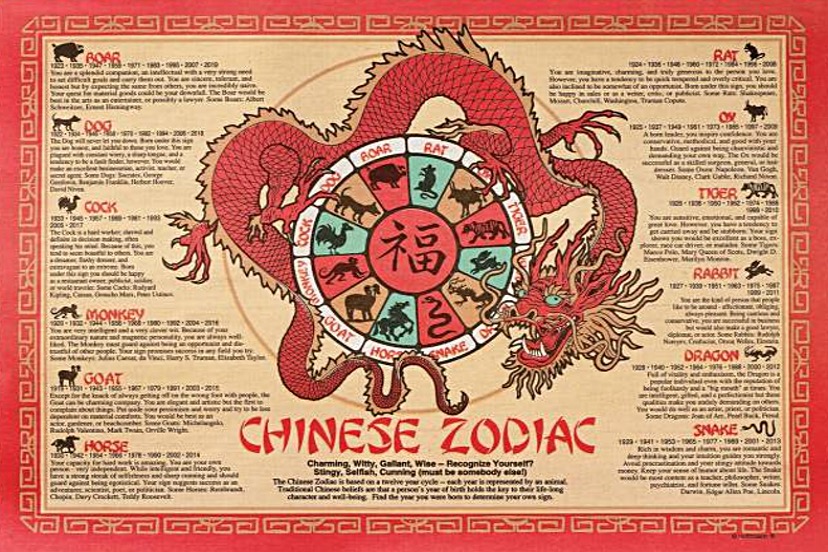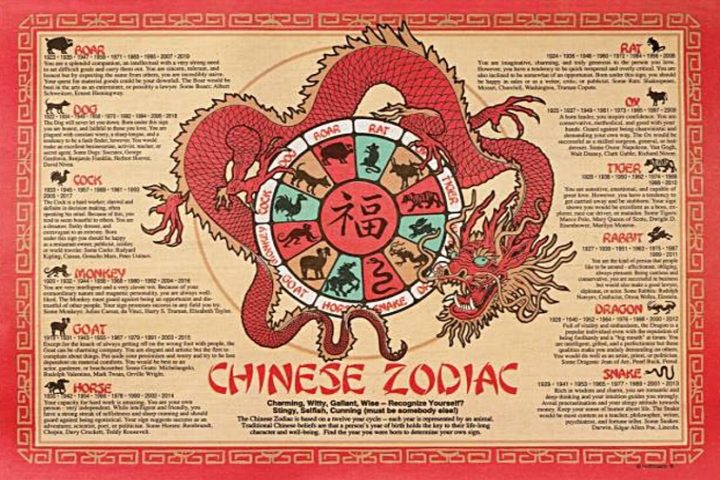It seems, the older I get, the more I’m questioning aspects of our society’s generally accepted reality.
Mythical animals never posed any special intellectual challenge for me when I was a kid. I had learned that certain prehistoric animals like Saber Tooth Tiger and Tyrannosaurus Rex — as unbelievable as they might have appeared — actually walked upon the earth a time long ago, but became ‘extinct’ for some reason.
I also learned that certain other animals that were perhaps no more unbelievable — like Dragons and Unicorns — were “mythical” and had never truly existed, except in the active imaginations of human beings.
Then one day, we were sitting around the table at a Chinese restaurant and discussing the “Chinese Zodiac” information printed on the paper place mats. Who was born in the Year of the Rabbit? The Year of the Snake? The Year of the Dog?
I already knew that I’d been born in the Year of the Dragon, and as a result, purportedly exhibited certain personality traits common to all ‘Year of the Dragon’ people. Supposedly, I am most compatible with Monkeys, Rats, and Roosters.
But on this particular evening, I noticed something very odd about the 12 animals. Almost all of them were “real” animals — not only “real” but also very common animals, found in every corner of the globe. Cat, Pig, Horse, Goat, Ox…
Except the Dragon. My own zodiac sign. The Dragon, I knew, was mythical. No dragons had ever existed on planet earth. Dragons were entirely imaginary.
Really? Why, then, was the Dragon included on this Chinese restaurant place mat — and on every Chinese restaurant place mat I’d ever seen — surrounded by 11 perfectly real, and common, animals?
That didn’t make any sense to me.
Is it possible… that Dragons were once just as perfectly real, and common, as dogs and cats and pigs and roosters… but somehow became extinct… like the thousands of other species that science tells us have suffered extinction, down through the ages?
We have seen numerous animals species become extinct just within the past 200 years. The dodo bird. The passenger pigeon. The eastern hare wallaby. The long-eared mouse. The Caribbean monk seal. The red gazelle. The Falkland Islands wolf. The western black rhino. Dozens of documented extinctions, just since the time my grandfather was born.
How about it? Was the Dragon among the many animals that have disappeared since the beginning of Chinese civilization? That could explain his position in the Chinese Zodiac, among 11 other common animals. We don’t really know, and we may never know. Science can tell us many things about Planet Earth, but some knowledge remains stubbornly beyond our reach.

How likely is it… that humans, living 1,000 years from now, will believe the rhinoceros is a mythical animal… the very same way we now believe the Unicorn is a mythical animal? The distant past is always mysterious.
Another thing that’s particularly unknowable, mysterious, and imaginary: The future.
Much of the “Final Draft” of the West Fork Water Rights Alternative Study (which you can download here if you haven’t already) deals with the future. The San Juan Water Conservancy District had discussed that study in some detail on February 15. It sounds like the final Final Draft will be discussed again in April.
Note: I currently serve as an appointed volunteer on the San Juan Water Conservancy District, serving the taxpayers of Archuleta County. The following editorial expresses my own research and opinions, and does not necessarily reflect the opinions of any other SJWCD Board members, nor the decisions and policies of the SJWCD Board as a whole.
We humans often try and imagine the future by looking at the past and the present, construct what we think are the current trends, and then assume that those current trends will continue indefinitely into the future.
Once we have a picture of an imaginary future — if we can agree on one — we can take cooperative actions to prepare for that future, or even try to prevent it from happening. Millions of people, for example, have seemingly agreed on a picture of an imaginary future where ‘climate change’ and other factors will significantly reduce the amount of fresh water available to the growing population of the American West.
Certain people are frightened by that future prospect, and would like the rest of us to be equally frightened.
We ran an editorial series about that problem, a couple of years ago. The series kicked off with a quote from Kelly Brough, the president of the Denver Chamber of Commerce — a person who may have reason to be frightened about a future water crisis.
That quote:
“No one will ever consider wasting water once this [ad] campaign is done…”
Ms. Brough was, at that time, a member of a political coalition called ‘For the Love of Colorado’. The coalition’s goal was to convince Colorado voters to voluntarily increase their own taxes, to fund a $40 billion ‘water plan’… so they had hired a marketing company called “Sukle”… an agency that bills itself online as “Sukle: Denver’s Top Advertising & Design Agency.”
‘For the Love of Colorado’ was not trying to spread love, however. They had asked this marketing company to spread fear and alarm all across the state, with a multi-media advertising campaign that warns taxpayers that Colorado is running out of water.
We all understand that there’s nothing like fear to motivate people. And the fear of living in a waterless desert probably ranks pretty high on the scariness scale, no matter if you’re a farmer, a fishing guide, or a school teacher.
‘For the Love of Colorado’ was calling it an “awareness campaign,” but what the organization really wanted was to convince state residents to pay more for water management and infrastructure all across the state.
A lot more.
Another clever way to spread fear into the hearts of voters, the folks at Sukle suggested, would be to create “Dry River Rafting” art installations, on sidewalks in Denver and other populated Colorado cities.
The Sukle marketing ideas, aimed at frightening Coloradans into voting for big tax increases, were posted on the Colorado Contractors Association website recently, as part of a 28-page Powerpoint document, Funding Colorado’s Water Plan, which you can download here.
According to their website, the ‘For the Love of Colorado’ coalition was sponsored by 21 “Partners”… a mix of ten environmental groups, a couple of industry organizations, two water districts and a handful of miscellaneous agencies. The Steering Committee represented a similar mix… except that the environmental groups were basically missing.
The website does not mention the Walton Family Foundation as a sponsoring “partner.” Nor does it mention Denver Water. But somehow, those two organizations made it onto the Steering Committee.




